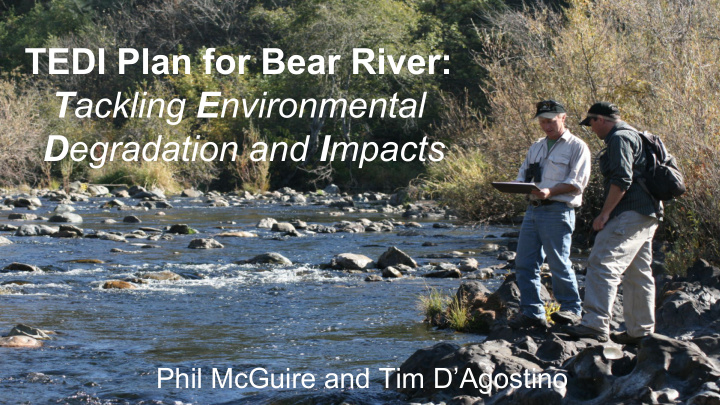



TEDI Plan for Bear River: T ackling E nvironmental D egradation and I mpacts Phil McGuire and Tim D’Agostino
Overview ● Mission Statement ● Watershed Characteristics ● Land Use ● Water Use ● History ● Environmental Problems ● Existing Organizations ● Problems and Solutions ● Recommendations
Mission Statement The T.E.D.I. Plan for Bear River seeks to restore fishable and swimmable water quality in the Bear River Watershed by 2045.
Watershed Characteristics ● Part of the American River Subregion of the Sacramento River Watershed ● Comprised of 4 counties (Placer, Sutter, Nevada, and Yuba) ● Origin: Sierra Nevada Mountain Range (Elevation 5,000 ft) ● Terminus: Feather River (Elevation ~ 100 ft) ● Area: 220,000 acres ● Annual Precipitation: 25-45 inches
Land Use ● Composition: 990 miles of streams, creeks, and rivers ● Development: 2,000 miles of roads within the watershed (45% of streams are within 100 m of a public road) ● Urban, Forest, and Cropland are major land designations
Water Use ● Mining - canals and sluice boxes ● Agricultural growth in 1800s and 1900s increased irrigation needs ● Dams built to encourage farming ● In the late 1880s and early 1900s, hydroelectric dams were built ● In 2011, the Nevada Irrigation District proposed a dam for city drinking water ● In 2014, a new dam proposal was introduced
History ● First settled ~3,000 BC by Nisenan Native American tribe ● Region discovered in the 1800s ● Settlement accelerated with the California Gold Rush ● Gold mine construction contributed to sediment runoff and mercury contamination ● Agriculture later increased irrigation needs in the 1800s and 1900s ● During the same period, several hydroelectric dams were constructed
Environmental Problems ● I. Fishery Destruction ● II. Water Quality Contamination ● III. Reduced Water Flow
I. Fishery Destruction ● Salmon and Steelhead populations ● No self-sustaining salmon runs exist ● Restoration of fishery benefits ○ Return of predatory species ○ Economic boost/tourism ○ Funding for additional management
II. Water Quality Contamination ● Mercury and bacteria ● Biomagnification ● Safety monitoring ● Benefits of improved water quality ○ Swimmable/fishable goal ○ Tourism
III. Reduced Water Flow ● Greater population demands more water ● Dam/Reservoir construction ● Less for downstream communities/habitats ● Benefits of increased flow ○ Reduced water stress ○ Protection of river for future generations
Problems and Solutions Problem Number (P) Goal Number (G) Solution Number (S) P1: Fishery Destruction G1.1: Mitigate Effects of Dams S1.1.1: Fishways/Ladders/Elevators S1.1.2: Halt Dam Construction G1.2: Minimize Methylmercury S1.2.1: Limit Eutrophication Contamination S1.2.2: Monitor Contamination P2: Water Quality G2.1: Mercury Remediation S2.1.1: Thermal Desorption S2.1.2: Phytoextraction G2.2: Healthy Vegetative Cover S2.2.1: Riparian Buffers S2.2.2: Controlled Burns P3: Reduced Water Flow G3.1: Reduce Water Consumption S3.1.1: Public Education S3.1.2: County Ordinances G3.2: Increase Groundwater S3.2.1: Reduce Impervious Cover Storage S3.2.2: Employ Aquifer Storage
Existing Programs and Organizations ● CABY ● SRWP ● Sierra Watch ● Sierra Water Workgroup ● Placer Land Trust ● Bear Yuba Land Trust
Conclusions and Recommendations ● Implementation of T.E.D.I. Plan for Bear River Watershed ● Establishment of an overseeing committee ● Grassroots outreach and collaboration with political leaders ● Monitoring of progress
Recommend
More recommend